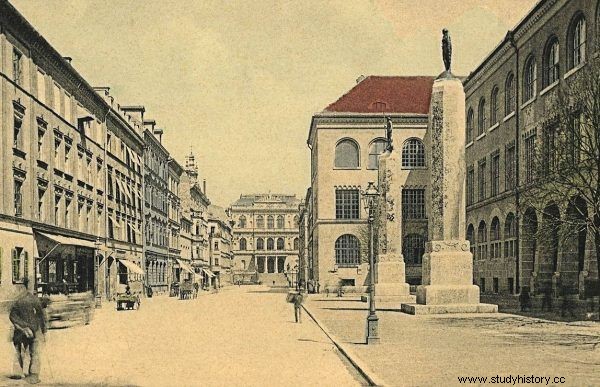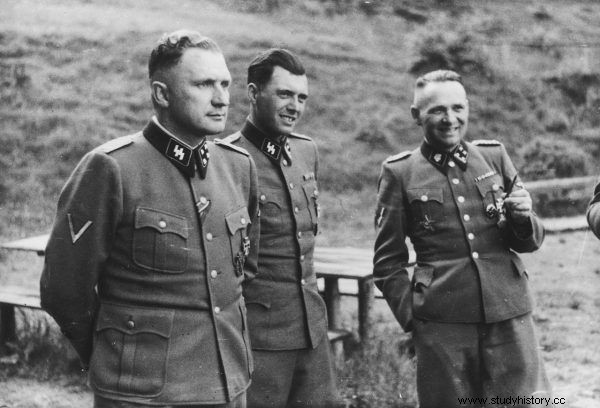In his youth, the Angel of Death had little interest in politics. Natural sciences were his passion at school. When he decided to study medicine, nothing foreshadowed his criminal career. How did dreams of healing replace pseudoscientific theories about race improvement?
In October 1930, young, confident and ambitious Josef Mengele, not interested in the sudden political changes in Germany, left his family home and went to the capital of Bavaria - Munich. The city quickly became intoxicated with the racist doctrines of Adolf Hitler's party (...).
Shortly after arriving in the city, Josef was admitted to the faculties of philosophy and medicine at the University of Munich. When Mengele began his studies, the Nazis were already the second largest party in the German parliament. Like many other young people, Josef was ultimately unable to "stand on the sidelines in these politically troubled times" (…).
In March 1931, the easily impressed Mengele already belonged to the youth outbuilding of the Stahlhelm, an organization of ex-soldiers whose members marched in field uniforms at public ceremonies. Josef liked the ceremoniousness of their paramilitary style. Although Stahlhelm was a nationalist and far-right organization, he had not yet associated with the Nazi party, for which Mengele was increasingly recognized.
First steps at university
(...) In Munich, Josef attended courses in anthropology, palaeontology, and medicine. He soon realized that he was more interested in the cultural roots and development of humanity than in treating human disease. Medicine taught at German universities corresponded to Mengele's interests, as it was based on Darwinian theories, close to the views of Hitler and most academics of the time.

Already in the early 1930s Josef Mengele belonged to the youth annex of the Stahlhelm. Illustrative photo.
It would be difficult to answer the question of the causes of Josef's sharp young mind. Perhaps it was a combination of a political climate, an interest in genetics and evolution, and the increasingly popular view that people with certain diseases should not reproduce or even live. The catalyst for Mengele's transformation was probably the fact that - first in Munich and then in Frankfurt - he had to meet the main proponents of the theory of "unfit for life" .
His main ambition has been to be successful in this new, fashionable area of research. Perhaps it was the idea that some people did not deserve to live, an idea that was soon to be academically recognized, that enabled Mengele ten years later to experiment with concentration camp prisoners as if they were laboratory rats.
It remains a mystery, however, what pushed Josef to commit criminal, so far unknown acts of violence, for which he did not show any remorse in his later life. "His personality showed no indication of his ability to commit such acts" , recalled Professor Hans Grebe, a contemporary of Mengele.
One of Josef's first mentors was Dr. Ernst Rudin, whose lectures Mengele regularly attended. Together with some of the world's leading representatives of the medical world, such as Dr. Alfred Hioche and Dr. Karl Bindong, Rudin preached that physicians should destroy "lives without values." He was also one of the authors of the Nazi laws on compulsory sterilization, which entered into force in July 1933, seven months after Hitler came to power (...).

The above text is an excerpt from the book by Gerald Posner and John Ware, "Mengele. Hunt for the Angel of Death from Auschwitz ”(Znak Horizon 2019).
The aim of Rudin - and other authors of the aforementioned law - was to improve the "quality" of the German race. In reality, however, Rudin laid the foundations for the escalation of planned genocide programs:first the euthanasia of people suffering from incurable mental illnesses, then the mass murder of people considered biologically inferior by the Nazis - Gypsies, Slavs and Jews; finally - Die Endlösung, "The Final Solution", the name coined by Hitler for the plan to exterminate all Jews in Europe.
Mentors
At the beginning of 1934, Mengele devoted more and more time to study (...). His growing ambitions meant that he started working on a doctorate in anthropology while trying to obtain a doctor's degree. In October 1934, a kidney disease forced him to leave the Sturmabteilung (Brown Shirts), an organization of brawlers to "protect" mass Nazi rallies. Mengele was automatically drafted into the Brown Shirts in January 1934 when Hitler ordered them to absorb the Stahlhelm. Josef was physically weakened by the disease; so he decided to devote all his energy to studying.
The person who made Mengele's rapid ascent up the academic ladder was Professor T. Mollinson from the University of Munich. He argued that knowledge of heredity and "racial hygiene" allows him to determine from a simple photograph whether a person had Jewish ancestors .
In 1935, Mollinson awarded Mengele with his doctorate for his work entitled Morphological Studies of Lower Jaw in Four Racial Groups (...). In the summer of 1936, Mengele passed the state medical examination in Munich and soon started his first paid job - at the clinic of the University of Leipzig.

Mengele was a graduate of the University of Munich.
Mengele served as junior resident physician for four months - a required period after which a full medical diploma could be obtained. The work was hard and during this time Josef's life did not change much - with one exception:in Leipzig he met the daughter of a university professor, Irene Schoenbein, who became his first wife (...).
Abandoning a lavish lifestyle, long working hours in the hospital, and relentless medical rounds, did not match Mengele's aspirations. He was tempted to go back to studying genetics. On January 1, 1937, on a recommendation from Professor Mollinson, Mengele was appointed an assistant at the prestigious Third Reich Institute of Heredity, Biology and Racial Purity at the University of Frankfurt. From that moment on, Mengele's life was about to change rapidly. He joined the research team of one of Europe's most eminent geneticists, Professor Otmar Freiherr von Verschuer, who devoted a lot of time to research on twins.
From theory to practice
Von Verschuer openly worshiped Adolf Hitler, saying that he was "the first statesman to pay attention to the biology of inheritance and racial hygiene" . Two years earlier, he defined the role of the Institute in the following words:"it is to provide a solid foundation for the care of genes and race, in which Germany excels, so that it can withstand attacks from outside."
Mengele quickly became the professor's favorite student; they both respected each other. Von Verschuer was almost certainly responsible for Mengele's transfer to Auschwitz, and later, as the wartime director of the Emperor Wilhelm Institute of Anthropology, Human Hereditary Sciences and Genetics in Berlin, he organized funds for the experiments carried out in the camp (it was to this institute that Mengele sent the results of his barbarian and largely worthless research).

It was Professor Otmar von Verschuer who was responsible for Mengelefgo's transfer to Auschwitz. In the photo, the Angel of Death is standing in the center.
Mengele was now at the epicenter of the Nazi philosophical and scientific doctrine that it was possible to select, refine, and "purify" the Germanic race. There was only one, very short, though tragic, step from this conception to the Nazi policy of genocide.
Mengele's entry into the NSDAP, indoctrinated by Nazi racial theories, was a mere formality. In May 1937 he applied and soon received a membership card with the number 5574974. As a party member, with the support of Baron von Verschuer, Mengele was guaranteed a quick promotion in the Nazi academic hierarchy.
Not much later, Mengele and von Verschuer began working closely writing reports for special tribunals judging Jews caught having relations with German Aryans (…).
"Daddy Mengele"
In such a climate, Mengele for the first time indulged in the concept of "improving" the breed by appropriate selection of its members. Soon, this theory was to be implemented - on the Auschwitz ramp, where SS doctors, mainly Mengele, sent physically fit prisoners to work, and the rest - to the gas chambers. Without resistance, Mengele let himself be drawn deeper and deeper into this pseudoscientific trap.

On the ramp in Auschwitz, Mengele realized his criminal concept of "improving" the race.
Helmut von Verschuer, son of his Frankfurt mentor, described Mengele as "a cheerful man, known among the secretaries in his father's office - whom he liked - as" Daddy Mengele "." Professor von Verschuer certainly had a very good opinion of Mengel, as he soon appointed him one of his assistants. This position made Mengele a de facto doctor, although he did not yet have a medical degree. Von Verschuer later wrote about his protégé:
He had a keen interest in medical research and surgery, and was intelligent and well mannered. He loved music; especially Bach and Verdi and, of course, Strauss and Wagner.
Mengele must have liked Puccini's works as well, because when making selections on the ramp at Auschwitz, he would sometimes whistle his arias as some prisoners mention in their gloomy accounts.
Mengele, although he was only twenty-seven years old, had already won the favor of the leading doctors and ideologues of the Third Reich. So it was obvious that he should have joined the organization seen as the guardian of the racial purity of the Germans:the Schutzstaffel, or SS. By the way, he also joined NS Arztebund, the association of most Nazi doctors with high aspirations.

The above text is an excerpt from the book by Gerald Posner and John Ware, "Mengele. Hunt for the Angel of Death from Auschwitz ”(Znak Horizon 2019).
In May 1938, after a ritual inspection of the Mengele family tree for four generations and finding that Josef had no Jewish or non-Aryan blood in him, he was admitted to the ranks of the SS. Vanity made him refuse to get a blood type tattoo, which was required of all new SS recruits.
Mengele attached great importance to elitism:instead of becoming an ordinary doctor, he chose a career in science, then entered the Third Reich Institute and the Kaiser Wilhelm Institute, institutions leading in the study of eugenics, and finally became a member of the Waffen SS - the elite of the elite.
"Save humanity from self-destruction"
In July 1938, the University of Frankfurt awarded Mengele a degree in medicine. So Mengele became a licensed physician. As the clouds of war gathered over Europe, Mengele did not want to remain aloof from what he saw as an inevitable but glorious fight.
The desire to join the SS field unit meant that in October he began a three-month basic training in the Wehrmacht - a regular German army (this training was a requirement to join the elite Waffen SS formation). To his delight, he was immediately sent to the Snalfedon-Tirol mountain region where his skiing skills were of the essence.

In 1938 Josef Mengele was admitted to the ranks of the SS.
After completing his training, Mengele returned to the University of Frankfurt to continue his research under Professor von Verschuer. Apart from a brief internship at the university clinic in Bonn, where he attended indoctrination lectures for members of the SS in his spare time, Mengele remained at the Institute until June 1940, when he joined the army (...).
Mengele identified himself fully with the influence that National Socialism had on genetics taught at German universities in the 1920s and 1930s. Nazi racial doctrines and earlier concepts of social Darwinism merged in Mengele's mind into a coherent worldview that would accompany him for the rest of his life.
He was convinced that he served a great cause:Hitler's attempt to save humanity from self-destruction. said Professor Andreas Hillgruber, a West German historian who studies Mengele's autobiographical records of races. "He became the embodiment of extreme Nazism."
In July 1939, in Oberstdorf, Mengele married Irene, who was then twenty-two (...). War broke out five weeks after the wedding. Mengele's son, Rolf, claims that “this made my father happy. He was looking forward to being drafted into the army. ”
Source:
The above text is from a book by Gerald Posner and John Ware Mengele. The Hunt for the Angel of Death from Auschwitz , published by the Znak Horyzont publishing house.
The title, lead, illustrations with captions, text in square brackets, bolds and subtitles come from the editors. The text has undergone some basic editing to introduce more frequent breakdown of paragraphs. For the sake of uniformity of the text, footnotes in the book version have been removed.
Check where to buy "Mengele. The Hunt for the Angel of Death from Auschwitz ”:
